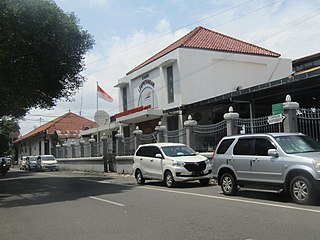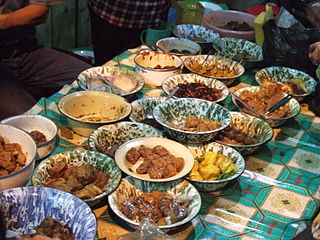
Satay, or sate in Indonesian spelling, is a Southeast Asian form of kebab made from seasoned, skewered and barbecued meat, served with a sauce.

Cirebon is a port city on the northern coast of the Indonesian island of Java. It is the only coastal city of West Java, located about 40 km west of the provincial border with Central Java, approximately 297 km (185 mi) east of Jakarta, at 6°43′S108°34′E. It had a population of 296,389 at the 2010 census and 333,303 at the 2020 census; the official estimate as at mid 2022 was 341,235.

Cirebon Regency is a regency (kabupaten) of West Java, Indonesia. Sumber is its capital. It covers 1,076.76 km2 and had a population of 2,068,116 at the 2010 census and 2,270,621 at the 2020 census; the official estimate as at mid 2022 was 2,315,417. These area and population figures exclude those of Cirebon City, which is an independent administration, although totally surrounded by the regency on its landward side.

Lempuyangan Station is a railway station located in Bausasran, Danurejan, Yogyakarta, Indonesia. It is 1 kilometre (0.62 mi) east of Yogyakarta Station, 114 metres (374 ft) above sea level. The station is part of Operational Area VI Yogyakarta. It has 11 lines, including two straight tracks.

Ketoprak is an Indonesian vegetarian dish from Jakarta, consisting of tofu, vegetables, rice cake, and rice vermicelli served in peanut sauce.

Rempeyek or peyek is a deep-fried savoury Indonesian-Javanese cracker made from flour with other ingredients, bound or coated by crispy flour batter. The most common type of rempeyek is peyek kacang ; however, other ingredients can be used instead, such as teri, rebon, or ebi. Today, rempeyek is commonly found in Indonesia and Malaysia, as well as in countries with considerable Indonesian migrant populations, such as The Netherlands and Suriname.

Jatibarang Station is a railway station at Mayor Sangun Street (Market), Jatibarang, Jatibarang, Indramayu Regency, West Java. It is on the main northern Java route line from Jakarta to Surabaya.

Cirebonese mask dance is a local indigenous art form of Cirebon in Java, including Indramayu and Jatibarang, West Java and Brebes, Central Java. It is called mask dance because the dancers use masks when dancing. There is a lot of variety in Javanese mask dance, both in terms of the dance style and the stories to be conveyed. This mask dance can be performed by solo dancers, or performed by several people.

Empal gentong is a spicy Indonesian curry-like beef soup originating in Cirebon, West Java. It is a variety of the Soto cuisine and is similar to gulai that is usually cooked with firewood in a gentong stove. The ingredients include cuts of beef, and cow offal such as intestine, tripes, lungs, etc. cooked with curry-like spices in coconut milk, garlic, chilies, chives (kuchai) and sambal in the form of chilli powder. Empal gentong can be eaten with steamed rice, ketupat or lontong. Empal gentong originated from Battembat, Tengah Tani, Cirebon Regency.

Nasi jamblang is a typical food of Cirebon, West Java. The "jamblang" term comes from the name of the region to the west of the city of Cirebon, where food vendors first sold the dish. A characteristic feature of the dish is the usage of teak leaves to pack the rice. The dish is served buffet-style.

Tahu Gejrot is an Indonesian fried tofu in sweet spicy sauce from Cirebon, a port city in West Java, Indonesia. Tahu gejrot consists of tahu pong, a type of hollow tahu goreng cut into small pieces. It is served with a thin and watery dressing that is made by blending palm sugar, vinegar and sweet soy sauce. It is usually served in a small earthenware bowl or layah, with ground garlic, pounded shallot and hot bird's eye chili cut into pieces to add spiciness. Tahu gejrot is usually served in a clay plate.

Mie koclok, is an Indonesian chicken noodle soup, a specialty of Cirebon city, West Java. The noodles come with a white-colored extra-thick porridge-like soup, made of chicken broth and coconut milk soup, which is coagulated with corn starch or tapioca. Other ingredients include shredded chicken breast, cabbage, bean sprouts, hard boiled egg, kaffir lime juice, and sprinkled with sliced fresh celery, spring onion, and fried shallot.

Mie kocok, is an Indonesian beef noodle soup, specialty of Bandung city, West Java. The dish consists of noodles served in rich beef consommé soup, kikil, bean sprouts and bakso, kaffir lime juice, and sprinkled with sliced fresh celery, scallion and fried shallot. Some recipes might add beef tripe.

Kue gapit is an Indonesian kue kering which originates from Cirebon, West Java. Generally made from tapioca flour, its name comes from the cooking process, in which it is grilled between iron molds like a waffle. The snack comes in a variety of shapes and flavors. Though it is a popular souvenir among visitors to Cirebon, residents of the region rarely eat it.

Krupuk (Javanese) is a cracker made from starch or animal skin and other ingredients that serve as flavouring. Most krupuk are deep fried, while some others are grilled or hot sand fried. They are a popular snack in maritime Southeast Asia, and are most closely associated with the culinary traditions of Indonesia, in particular Javanese cuisine. It is an ubiquitous staple in its country of origin, and has spread to other countries either via the migration of diaspora populations or exports.

Fish crackers are deep fried crackers made from fish and spices, originating from Indonesia. The crackers are made mainly with tapioca flour and/or sago flour and then salt, sugar and MSG as seasonings. Fish crackers can be found throughout Southeast Asia and East Asia. However, they are more commonly found and of greater variety in Indonesia and Malaysia.

Mi caluk is a traditional Indonesian-Aceh noodle dish, which is commonly found in traditional markets and food courts in Pidie Regency and Pidie Jaya Regency.

Tinorangsak or tinoransak is an Indonesian hot and spicy meat dish that uses specific bumbu found in Manado cuisine of North Sulawesi, Indonesia. The most common meat used in tinorangsak is pork. However, other kind of meat such as beef, chicken or seafood might be used as well. Spices mixture includes chili pepper, shallot or onion, ginger, lime leaves, lemongrass, lime juice, cooking oil, and salt.

Pekasam, Pakasam or Bekasam is a Malay term for fermented food, more precisely fermented fish product. In Malay and Banjar cookery, pekasam usually refers to freshwater fish fermented with salt, palm sugar, toasted rice grains and pieces of asam gelugur.



















